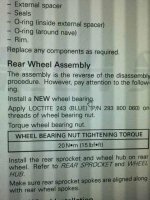Flamewinger
New member
I've seen both ways to install new bearings, either using grease around the outside of the bearing and inside where you're going to install it, and some don't use any grease at all. The service manual shows & specifies how to remove the bearings using a blind bearing puller, but when it comes to installing new bearings all it says is "install new bearings".
Use grease or not?
Susie
Sent from my iPad using Tapatalk
Use grease or not?
Susie
Sent from my iPad using Tapatalk


